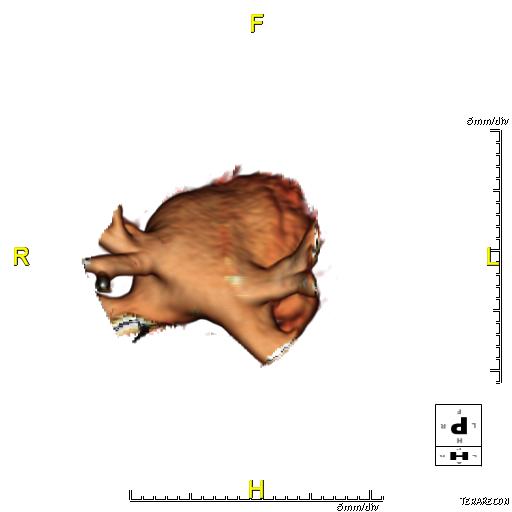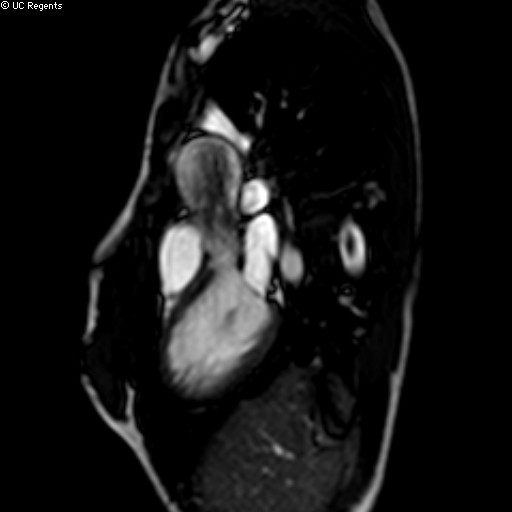Karen Ordovas, MD, MAS Discusses the Benefits of Cardiac MRI
Cardiovascular magnetic resonance imaging (CMR) or cardiac MRI is a medical imaging technology that provides a noninvasive diagnostic assessment of the cardiovascular system. Cardiac MRI helps to achieve improved diagnosis and further guide management of treatment of patients with heart disease. A major benefit of this particular imaging modality is that it uses no radiation.
 "For some patients, using cardiac MRI makes sense," says Karen Ordovas, MD, MAS, director of Cardiac Imaging in the UC San Francisco Department of Radiology and Biomedical Imaging. "Let's say you have a patient who is 20 years old with cardiomyopathy, a chronic heart problem. This requires serial imaging for the rest of the patient's life. Even if a CT scan is done with low dose protocols, cardiac MRI is a reproducible method that has no radiation. This is important."
"For some patients, using cardiac MRI makes sense," says Karen Ordovas, MD, MAS, director of Cardiac Imaging in the UC San Francisco Department of Radiology and Biomedical Imaging. "Let's say you have a patient who is 20 years old with cardiomyopathy, a chronic heart problem. This requires serial imaging for the rest of the patient's life. Even if a CT scan is done with low dose protocols, cardiac MRI is a reproducible method that has no radiation. This is important."
"I wouldn't want to stress that computed tomography (CT) has a lot of radiation, that's not the case anymore," explains Dr. Ordovas. "But with serial imaging, there is prolonged exposure to radiation, and this could have a really have a big impact over a patient's lifetime."
Elimination of radiation by using cardiac MRI is especially important in women as breast tissue is sensitive to radiation. With this in mind, less radiation exposure is best.
 Another benefit is that in one, single study, cardiac MRI allows a radiologist to look at multiple features of a patient's heart. First, a radiologist can look at morphology, the anatomy aspect of the heart. Beyond that, a radiologist can look at the heart function - how it contracts; how the blood moves inside the heart (flow dynamics). On top of that, cardiac MRI provides radiologists with ways of looking at the tissue of the cardiac muscle itself to decide what components make that muscle. Is it a scar? Is it edema? Is it normal muscle? Is it accumulation of glycogen or some type of deposition material?
Another benefit is that in one, single study, cardiac MRI allows a radiologist to look at multiple features of a patient's heart. First, a radiologist can look at morphology, the anatomy aspect of the heart. Beyond that, a radiologist can look at the heart function - how it contracts; how the blood moves inside the heart (flow dynamics). On top of that, cardiac MRI provides radiologists with ways of looking at the tissue of the cardiac muscle itself to decide what components make that muscle. Is it a scar? Is it edema? Is it normal muscle? Is it accumulation of glycogen or some type of deposition material?
"When you put a patient in the MRI machine, different tissues behave in different ways, and create a different type of image," says Dr. Ordovas. "MRI is what we use for brain imaging, for body imaging… for many types of imaging. As radiologists, we get to a point where cardiac imaging is so precise, that inside the myocardial fibers, we can identify the type of tissue that is generating the signal, and that has been correlated with explanted hearts and histology, and for some of the diseases like fibrosis, MRI imaging correlates really well."
Additionally, if you use a method in imaging called T2 star (T2*) for tissue iron assessment in the heart, you can detect iron deposition in the patient's heart, quantify how much iron and predict the likelihood of whether a heart is going to fail or not. Patients that have a lot of blood transfusions end up accumulating iron deposits in the heart. This is a huge cause of heart disease within that population. With cardiac MRI you can detect the iron, quantify the iron, and then after treatment with chelation medicine you can image again to see if it has improved. This knowledge tailors the whole management of the patient.
 Overall, the field is now moving into calling cardiac MRI the "virtual biopsy." In the past, invasive procedures such as biopsies were needed to help diagnose and detect certain heart diseases. However, using cardiac MRI can eliminate this invasive procedure, and can be just as accurate to detect as a cardiac biopsy.
Overall, the field is now moving into calling cardiac MRI the "virtual biopsy." In the past, invasive procedures such as biopsies were needed to help diagnose and detect certain heart diseases. However, using cardiac MRI can eliminate this invasive procedure, and can be just as accurate to detect as a cardiac biopsy.
"It is a surrogate, it's not the exact biopsy, but it's so close and it correlates so well with the results of the biopsy that you don't need to do a biopsy anymore for some heart diseases," says Dr. Ordovas. "This really revolutionizes the diagnosis of some heart diseases like sarcoidosis and amyloidosis."
The Cardiac and Pulmonary Imaging Section at UCSF Radiology offers cardiac MRI for patients. We partner with patients and their families, researchers from our own and other institutions, donors and other visionaries along with referring colleagues in the fields of Cardiology, Thoracic Surgery, Pulmonary Medicine, Oncology, Infectious Disease and Primary Care/Internal Medicine. Visit the section's page to learn more.
For further information on heart MRI go here.
